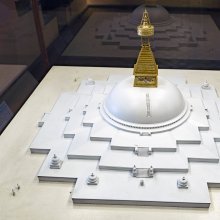Nyingma: 2 definitions
Introduction:
Nyingma means something in Buddhism, Pali, the history of ancient India. If you want to know the exact meaning, history, etymology or English translation of this term then check out the descriptions on this page. Add your comment or reference to a book if you want to contribute to this summary article.
Images (photo gallery)
In Buddhism
Tibetan Buddhism (Vajrayana or tantric Buddhism)
Source: WikiPedia: Tibetan BuddhismThe Nyingma tradition is the oldest of the four major schools of Tibetan Buddhism (the other three being the Kagyu, Sakya and Gelug). "Nyingma" literally means "ancient," and is often referred to as Ngagyur (Tibetan: སྔ་འགྱུར།, Wylie: snga 'gyur, "school of the ancient translations" or "old school") because it is founded on the first translations of Buddhist scriptures from Sanskrit into Old Tibetan in the eighth century. The Tibetan alphabet and grammar was actually created for this endeavour.
The Nyingma tradition actually comprises several distinct lineages that all trace their origins to the Indian master Padmasambhava, who is lauded in the popular canon as the founder of Tibetan Buddhism in the eighth century, and is still propitiated in the discipline of reciprocity that is guru yoga sādhanā, the staple of the traditions.
Nyingma maintains the earliest Tantra teachings that have been given the popular nomenclature of Vajrayana. Early Vajrayana that was transmitted from India to Tibet may be differentiated by the specific term "Mantrayana" (Wylie: sngags kyi theg pa). "Mantrayana" is the Sanskrit of what became rendered in Tibetan as "Secret Mantra" (Wylie: gsang sngags): gsang sngags is the self-identifying term employed in the earliest literature, whereas Nyingma became associated in differentiation from the "New Schools" Sarma.

Tibetan Buddhism includes schools such as Nyingma, Kadampa, Kagyu and Gelug. Their primary canon of literature is divided in two broad categories: The Kangyur, which consists of Buddha’s words, and the Tengyur, which includes commentaries from various sources. Esotericism and tantra techniques (vajrayāna) are collected indepently.
India history and geography
Source: academia.edu: The Chronological History of Tibetan BuddhismNyingma refers to one of the four major schools of Tibetan Buddhism.—Nyingma is the oldest school. Guru Rinpoche or Padmasambhava II, a Tantric Vajrayanist brought the Nyingma teachings to Tibet during the reign of Trisong Detsen (95-144 CE). Evidently, the Nyingma school was founded in Tibet in the first half of the 2nd century. Vimalamitra and Vairochana were the earliest teachers of Nyingma tradition. Vairochana translated many Buddhist texts into Tibetan. Interestingly, no one served as the head of Nyingma tradition.

The history of India traces the identification of countries, villages, towns and other regions of India, as well as mythology, zoology, royal dynasties, rulers, tribes, local festivities and traditions and regional languages. Ancient India enjoyed religious freedom and encourages the path of Dharma, a concept common to Buddhism, Hinduism, and Jainism.
See also (Relevant definitions)
Starts with: Nyingmapa.
Full-text: Tibetan Buddhism, Bon, Padmasambhava, Samantabhadra, Mahayoga, Dzogchen, Nyingmapa, Jamgön Kongtrül, Tongpanyi, Kinnara, Vajrayana.
Relevant text
Search found 5 books and stories containing Nyingma; (plurals include: Nyingmas). You can also click to the full overview containing English textual excerpts. Below are direct links for the most relevant articles:
Bodhisattvacharyavatara (by Andreas Kretschmar)
Interview With Khenpo Pema Sherab < [Introduction Text]
Text Section 147 < [Khenpo Chöga’s Oral Explanations]
Text Section 183 < [Khenpo Chöga’s Oral Explanations]
Tibet (Myth, Religion and History) (by Tsewang Gyalpo Arya)
5. Buddhist Schools and the Politics of Tibet < [Chapter 7 - Buddhism in Tibet]
9. The Highest Yoga Tantra < [Chapter 7 - Buddhism in Tibet]
6. Bon and Buddhism < [Chapter 7 - Buddhism in Tibet]
Guhyagarbha Tantra (with Commentary) (by Gyurme Dorje)
12. The resurgence of the bka'-ma lineage in Central Tibet < [Introduction]
3. The texts of Mahāyoga < [Introduction]
The Way of the White Clouds (by Anāgarika Lāma Govinda)
Chapter 52 - The Happy Valley < [Part 4 - Return to Western Tibet]
Chapter 36 - Mystery-plays < [Part 3 - Death and Rebirth]
The Great Chariot (by Longchenpa)
